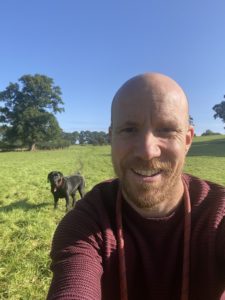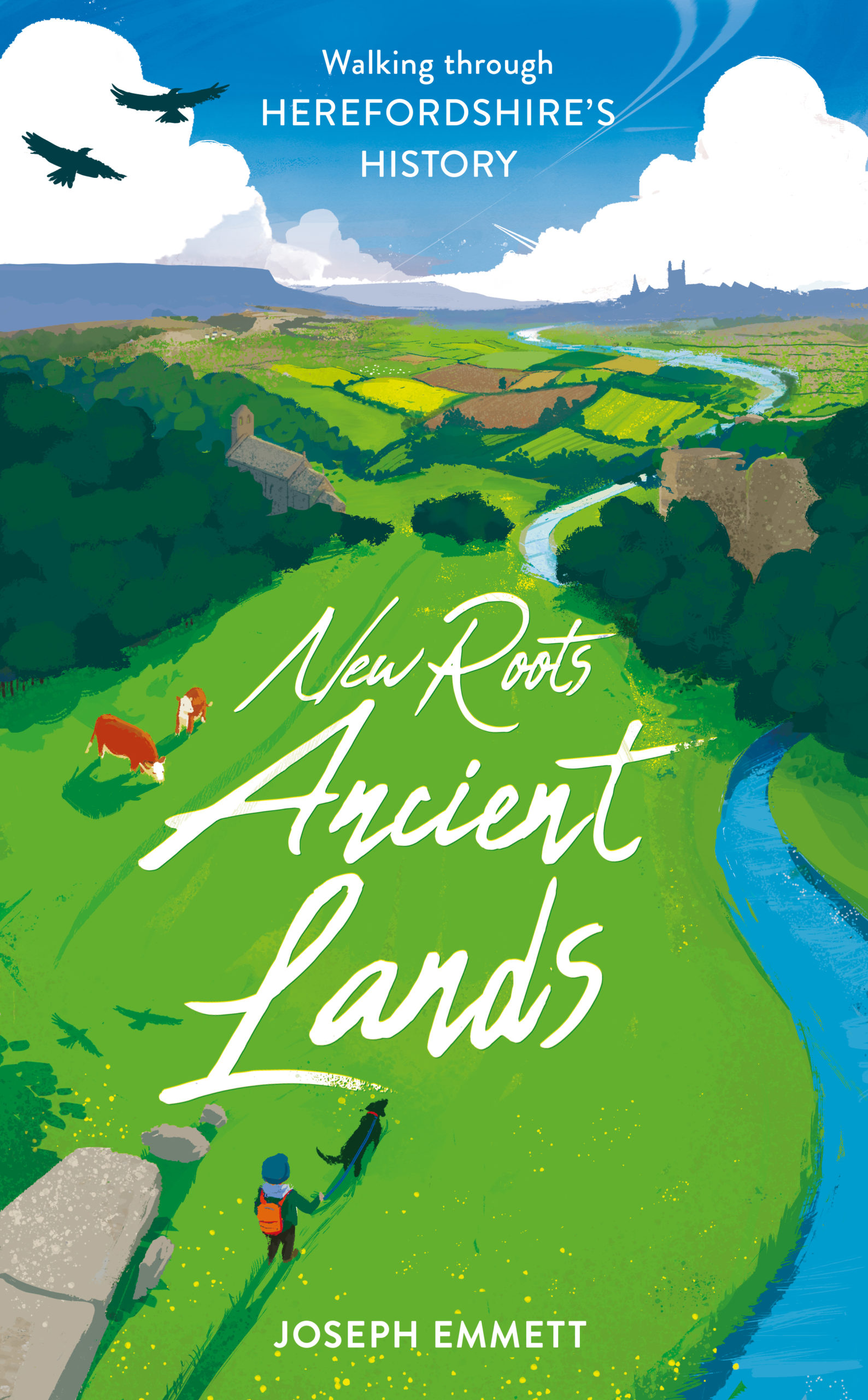New Roots, Ancient Lands
Walking Herefordshire's History
Herefordshire might easily be known as the ‘hidden county’ – close to the Cotswolds, hugging the Welsh Marches, just slightly south of Shropshire and Housman’s blue-remembered hills, this rural gem is often overlooked.
With the passion of an outsider who’s ‘blown in’, looking for home, Joseph Emmett sets out to discover the history of this apple-orchard border land from the Ice Age through to the twentieth century, on a pilgrimage that takes him across the county, his dog Juno at his side. Sometimes they walk alone, and sometimes in company with Vikings, farmers, conservationists and schoolchildren, up hills and across valleys, taking in castles, churches, a cathedral, Roman ruins and Stone Age monuments along the way.
What makes a place somewhere you can call home, and how – if at all – has that changed throughout time? In this personal journey through its history, Herefordshire’s past illuminates the people, places and landscapes that continue to shape its future.
Featuring walks that include:
Arthur’s Stone
Garway Hill
Mordiford and Haugh Woods
Ross-on-Wye
Snodhill and Wigmore castles, and many more.
About the author
 Joseph Emmett is a secondary school history teacher, activist and songwriter who lives in West Herefordshire on the English-Welsh border near Hay-on-Wye with his partner, two children and one black Labrador. Born in Southampton, he moved to Herefordshire from Bristol, via Cardiff, London and Brighton, and has been on a year-long quest to walk the county’s hills, valleys, woods and fields to better understand what it means to call Herefordshire home.
Joseph Emmett is a secondary school history teacher, activist and songwriter who lives in West Herefordshire on the English-Welsh border near Hay-on-Wye with his partner, two children and one black Labrador. Born in Southampton, he moved to Herefordshire from Bristol, via Cardiff, London and Brighton, and has been on a year-long quest to walk the county’s hills, valleys, woods and fields to better understand what it means to call Herefordshire home.
Prologue
‘No, not Hertfordshire, Herefordshire.’
‘Where’s that then?’
‘It’s in the west, north of Bristol, south of Birmingham, on the border with Wales. It’s truly beautiful.’
‘Blimey, no wonder I don’t know where it is. Sounds like the middle of nowhere.’
I must have had a version of this conversation at least half a dozen times each year over the last decade. It never fails to surprise me how so many people who live in Britain have so little idea of where Herefordshire is. Admittedly, some might say something about cider or cattle, but when pressed – not an intended pun – most will struggle to locate it geographically. But then, I too knew very little about this surprising and wonderful county before we moved here. Even after a decade of living, working and bringing up children here, driving and walking some of its landscape, one day I realised that I really didn't know enough about Herefordshire or its history. I felt this had to change, as did one other aspect of living here: in all the conversations I had about the county, l rarely, if ever, referred to it as ‘home’.
It was a thought that began to dominate my thinking about where we lived. Was it because I saw our move as potentially temporary, somehow, even after a decade?
Whenever I’d even considered thinking of Herefordshire as ‘home’, something within had stated quite clearly, This place can never be your home! Home was for those who were permanently rooted here, embedded into this land over many generations. If this was their home, how could someone ‘from off’ ever call it theirs? In any place, there can be understandable suspicion towards newcomers from those who have lived there all their lives. As a history teacher, songwriter and activist, I knew all too well that my dilemma was echoed in history and magnified a thousand times by others who had searched for a place to settle, often uprooted as they were by far greater forces than anything I could claim to experience – war, famine, oppression. It put my ‘problem’ into perspective. Not feeling able to call the place I live ‘home’ was, on the scale of those other issues, laughably small. However, I still wondered if there was ever a way you could root yourself into new lands, especially those as ancient as these.
Then, on a summer morning, high on a ridge overlooking the Herefordshire countryside, I was struck by the fact that if I wanted to call this place home – if I really wanted to – then I had a duty to know Herefordshire a whole lot better than I did. I wondered if it was possible to share the process of my discovery, learning as I could from those who knew the ‘lay of the land’ and the stories it held? Was this a way in to putting down those roots – through greater exploration of its history and landscape, could I come to feel and call Herefordshire home? Perhaps as a history teacher it is somewhat predictable to suggest that a key way to connect to a place is to explore the history of all that lies around us. If so, I am then guilty. However, it does seem to me that to truly grasp the essence of a place, to understand the landscape and its people, its history is an essential way to achieve a little of that ‘rootedness’ I sought. Let’s consider the people who have given blood, sweat and tears to achieve all that we now see. To hear those voices, past and present, from all angles and aspects, allows you to be enriched by the process of digging. Feeling rooted is perhaps not a birthright but can be honestly earned by listening to those who ‘know’; and those that know must also be willing to welcome those who arrive and wish to listen and learn.
Well, I was ready to do both. I thought by walking this landscape and learning its history, I might be able to wind a thread that others may follow, if they wish to walk this way. By writing this book, I hope to help a little in this regard, for it is not just a journey of discovery about Herefordshire but could work as a pattern for anywhere. I believe that only by reaching back can we ever move forward. I wanted to explore the places, people and events that have shaped Herefordshire and one thing was certain: if history was key then there had to be a chronology to these walks. I may have first come to my thoughts about home on an ancient ridge on a summer’s morning, but there were places even older with stories to share. With this in mind, I knew exactly where this book had to begin, with a feature that is unique to Herefordshire but one that not enough people seem to know about. It means going back to the time of ice.
